Opening the Black Box: Kevan Moffett Works at the Intersection of Land, Water and Life
December 20, 2012

With her research interests and enthusiasm flowing forth like a raging river when she speaks, it’s no surprise that Kevan Moffett studies the dynamic role of water in the earth sciences. As she begins her career at the Jackson School of Geosciences, Moffett will focus on the fields of hydrogeology and ecohydrology, exploring the relationships between groundwater and surface water and between water and ecological systems.
“Water is everywhere but we often take it for granted. We can’t live without it, yet we still have a lot to learn about how hydrologic systems work,” Moffett says. “Although we’re pretty good at moving water around for the benefit of humans, there’s still a lot we don’t understand about how water moves through natural systems and the sometimes under-appreciated functions it serves along the way.”
Moffett’s passion for water dates back to her childhood in Shaker Heights, Ohio, where she was frequently found stomping around in creeks. She channeled her interests into a degree in environmental engineering at Yale University, where a professor encouraged her to study hydrology. After working for a few years on the management of New York City’s drinking-water supply with a private engineering firm, Moffett decided to return to school for a graduate degree. She received her doctorate from Stanford University in 2010, using her dissertation to explore the complex interactions between groundwater movement, surface water dynamics, vegetation patterns, and wetland functions in an intertidal salt marsh in the San Francisco Estuary.
Now, Moffett is ready to get her feet wet at The University of Texas at Austin, focusing on the links between the groundwater, surface water, and ecology of wetland systems. She’ll be teaching courses and leading research in hydrogeology, which focuses on groundwater dynamics and water use, and the emerging interdisciplinary science of ecohydrology, which connects soils, water, vegetation, and the atmosphere.
“I’m really interested in the organization of landscapes and what causes spatial patterns in water flow and in vegetation,” Moffett says. “Wetland organization, in particular, is not well studied.”
Dynamic Wetlands

The organization of dryland environments has been more widely researched, partly because the flow pathways of scarce water are relatively easy to track and because sparse plant life makes vegetation patterns relatively obvious. In contrast, the lush mix of plants and the subtle movements of water in wetlands are more difficult to decipher. Not to mention, in the coastal systems Moffett has studied so far, continuous tidal flooding and saltwater exposure is brutal on stainless steel instruments (and field researchers), making field studies particularly challenging.
Moffett and others are only beginning to recognize and interpret the patterns in coastal wetland water movement and vegetation and how factors such as surface water-groundwater interactions, salinity, submergence, and water stress shape these environments.
Society has learned to value wetlands in recent decades for the benefits they provide in filtering pollution, maintaining water quality, and providing important fish and wildlife habitat. In the United States, the Clean Water Act protects wetlands to precisely preserve these important functions. Yet despite — and perhaps partly because of — their protected status, there has been a historical tendency to think of swampy landscapes as messy areas to be avoided, Moffett points out. This has ironically led wetlands to often be treated as “black boxes,” the internal functions of which are surprisingly not well understood.
“Now there’s a resurgence in wanting to get in there and get dirty,” she says, and to really understand what makes wetlands function.
Agro-Eco
Moffett is excited to “get dirty” while contributing to the fields of hydrogeology and ecohydrology. Her research group will conduct fieldwork in diverse environments, ranging from coastal to agricultural wetlands. Moffett also uses remote sensing image analysis and coupled surface water-groundwater numerical modeling to better understand these dynamic systems. Calling systems such as coastal and agricultural wetlands “natural laboratories,” she says the predictable cycle of tides or irrigation offers regular and repeated intervals for observing and studying the systems’ processes and responses.
With that in mind, she plans to establish a new network of wetland field sites along the Texas Gulf Coast. This network of sites will enable Moffett, colleagues, and graduate students to study plant-water interactions, groundwater and surface water movements, and the processes that control how coastal wetlands operate. With stations spanning the north-to-south and wet-to-dry climate gradient of the Gulf Coast, the network could be used to advise managers how to prepare for potential changes due to warming trends.
The hydrology and ecology of the sites could also be compared to coastal wetlands in other areas, such as the San Francisco Estuary where Moffett has worked for the past eight years. This pool of research could inform the creation of engineered wetlands for water treatment and habitat restoration and the management of existing wetlands for coastline protection and biodiversity.
Moffett’s interests in wetland dynamics also extend to studying the agricultural landscapes that produce rice and other staple crops that feed much of the world’s population.
“On a very practical level, we’ve known how to farm rice for thousands of years,” she says, “but, on a scientific level, we’re still learning a lot about what is actually going on physically, chemically, and biologically with the water and vegetation in the rice paddies. There are a lot of opportunities to peel back the layers of these well-known, but not well-understood, systems.”

The approach of studying the water and vegetation of farmed landscapes as if they are natural environments is a growing research frontier, called agro-ecohydrology. By applying her earth-systems perspective to these human-designed landscapes, Moffett expects to gain a new context for understanding connections between natural and irrigation flood events, groundwater fluctuations, land-atmosphere interactions, and crop productivity in wet farmland areas. Irrigation efficiency improvements, perhaps made in real-time using remote sensing information, could be another upshot of such research with global applications.
“Water use in agriculture is one of the tremendous challenges that humans face in the next couple of decades,” Moffett says, “so a deeper understanding of how these wetland agricultural-ecological systems work and how much water they really require is hugely important.”
In addition to her assistant professor position in the Jackson School, Moffett will hold a courtesy appointment in the Cockrell School of Engineering. The dual post will allow her to build connections between the schools and their disciplines and she sees many opportunities for partnerships, particularly on wetland restoration projects and remote sensing innovations. Collaborations with the University of Texas’ Marine Science Institute, located in Port Aransas, should also prove valuable in launching research projects along the Gulf Coast.
As she adds to the hydrogeology expertise and brings a new focus on ecohydrology to the Jackson School and the university, Moffett is excited to work with students and colleagues on a wide breadth of issues in the earth sciences. Much like the expansive web of coastal and agricultural wetland field sites she hopes to develop, there are plenty of areas to explore.
“As a hydrogeologist, I always come back to wanting to better understand how water gets into and comes out of the ground, and where it goes in between,” Moffett says. “With my interest in ecohydrology, I also want to figure out what physical, chemical, and biological mechanisms organize wetland systems. There are all sort of interesting feedbacks that operate in wetlands and in the near-surface zones of the earth that we’re just on the cusp of discovering.”
by Joshua Zaffos
